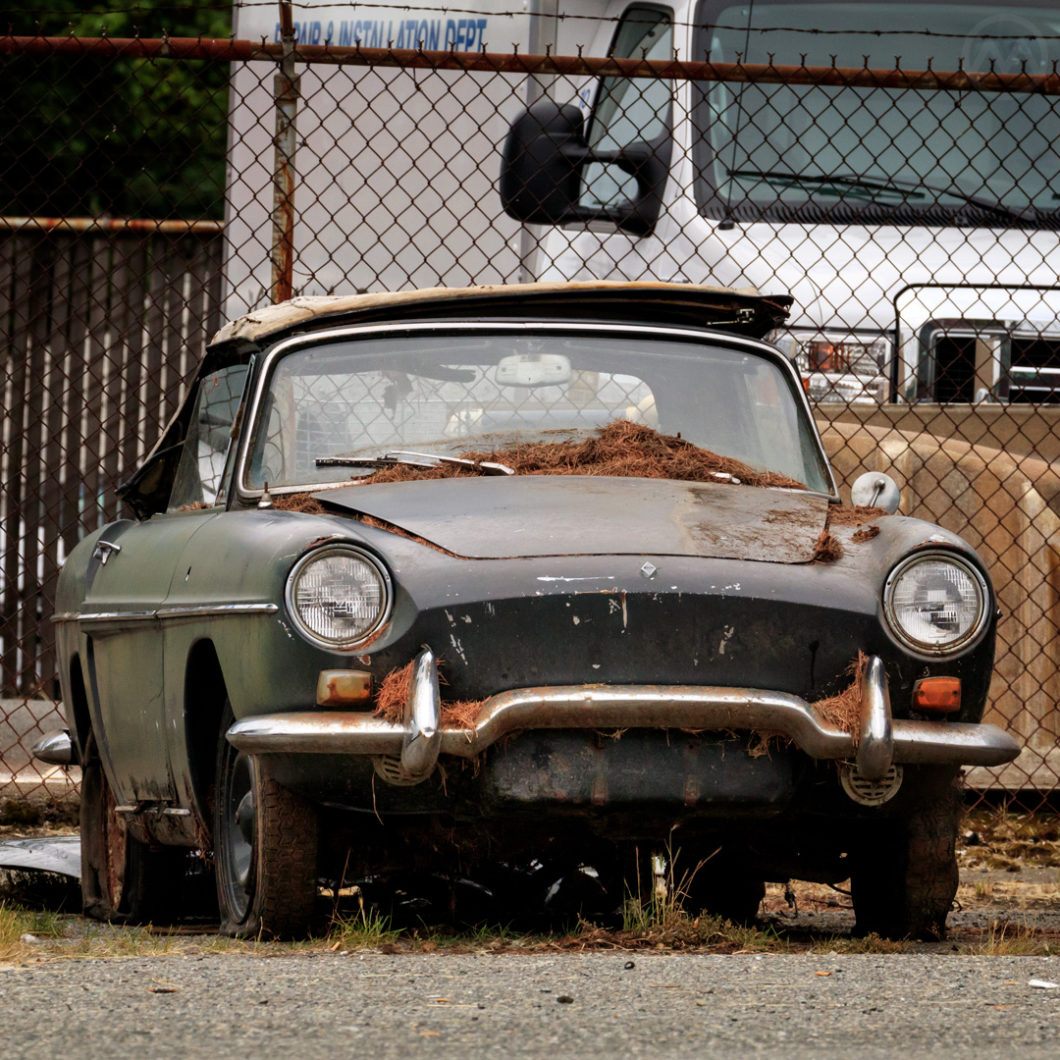This poor Renault Caravelle is in its final days – you can’t see it, but there’s virtually no structure left underneath – it’s been sitting outside in the bushes for decades and Caravelles are notorious rusters.
There are still plenty of Caravelles in France (where early ones were called “Floride,” more on that in a minute), but its rare to see them stateside even though the car was created specifically for the the American market and did pretty well here.
The story begins back in 1956, when Renault was making a major push to expand in the U.S.A. and take on VW directly. Renault’s U.S. sales grew by 500% – to ~91,000 cars, from 1955-59 (before they came crashing down in 1960-62).
The Florida Meeting
Pierre Dreyfus became Renault’s CEO in early 1955 and about a year later went on a fact-finding mission to the U.S. with long-time Renault engineer and director of research Fernand Picard; visiting many U.S. Renault stores and meeting with dealers in Florida.
Many American dealers saw how popular British sports cars were and VW had just introduced the Karmann-Ghia, which wasn’t a sports car but looked the part and helped sell lots of VWs. Renaults were new to many of them and they’d signed up to get a part of those markets. Fanchisees clamored for a K-G like car, and at a dinner at the home of Florida Governor LeRoy Collins, Dreyfus again heard about the Karmann-Ghia.
Thus he decided Renault should have its own Karmann-Ghia, based on the then-new Dauphine, itself a Ghia-styled car.
“Project 1902,” as it was first called, was designed in a hurry – the fact-finding happened in early 1956, the car appeared on the Renault stand, barely, at Geneva in October of 1958.
Another American Connection
It was built for style – an in-house design was eschewed in favor of a look by Ghia, who gave it the trademark “supersonic” look they also applied to bespoke Ferraris and Jaguars. Ghia also had an American connection to Chrysler, and there was a secret weapon in Ghia’s universe to strengthen the bona fides of the car in America – it was styled by Virgil Exner, Jr., son of the hottest American designer of the 1950s.
Exner Jr. was in the very earliest stages of his career at that time and actually serving in the U.S. Air Force in 1957. Working on contract, he did the initial designs and sketches for the Caravelle in his Air Force barracks, then sent them on in the mail to Ghia where they were finished up and turned into clays by Giovanni Savonuzzi.
Pietro Frua, working with Ghia to avoid a VW-Ghia conflict (Frua had sold his original firm to Ghia, but it operated as a separate entity to get around conflicts of interest), built the prototypes – but wasn’t paid until the day before the car appeared at the ’58 Geneva show. In front of Dreyfus, he threatened to display the cars as Fruas, but fortunately everyone was mollified by the time the show opened. Ultimately and the Caravelle led to an acrimonious split between Ghia and Frua.
Renault had no factory space for the Caravelle at Billaincourt or Flins, so bodies were built by Chausson and eventually, railroad car maker Brissonneau et Lotz built the cars entirely.
The car was initially called “Floride” in France, owing to it’s Floridian origins; but “Caravelle” was the global name.
Arriving Late
Like the Karmann-Ghia, it looked great but it definitely wasn’t a sports car. The 845-cc four from the Dauphine was even more overmatched in the 12” (30cm) longer, 300+ lb. heavier Caravelle.
It did have the right look, however, and 13,000 U.S. orders were taken for the car when it arrived stateside in early 1959. It matched the Karmann-Ghia on price, basically, and at first it did fairly well – but it desperately needed more engine.
It also came along at a time when Americans began to sour on Renault products – some of those dealers had little patience for Renaults and little interest in servicing them, and there were often quality ills. Sales began to slide in 1960 and came crashing down in 1962.
During this time, the Caravelle started to outshine the Dauphine with those buyers who were still interested, and it represented a solid seller even if the numbers were not huge overall. It had an appeal beyond the basic economy cars Renault was also selling, which was the whole point of a style car.
Significant upgrades eventually arrived, 956-cc in 1963, and then the 1108-cc “Sierra” engine in 1964; along with style changes and an upgraded suspension by none other than legendary engineer J.A. Gregoire. This is a later Caravelle with the R8-based underpinnings.
Basically the same idea as the Karmann-Ghia, the Caravelle dated more quickly than the VW owing to it’s very futuristic 1957 style – cutting edge then but beginning to look dated by the mid-1960s. The car continued in production into 1968 but by then U.S. exports had ended.
For more on the Caravelle, check out Renaultcaravelle.com.

